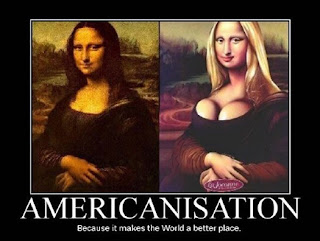I wanted to investigate the theme of our music video further, and so I scoured the internet for articles and information on the idea of media dominating our ideologies, and the ideologies of our society... I have created a post in the form of quotes, images, ideas and general snippets from the web...
"The concept of media and cultural imperialism was made prominent by a number of Latin American thinkers including Antonio Pasquali, Luis Ramiro Beltran, Fernando Reyes Matta, and Mario Kaplun."
"Adherents of the media imperialism tradition held that a small group of Western countries not only controlled the international media trade but used it to transmit their particular cultural and economic values, particularly individualism and consumerism, to large numbers of developing nations around the world."
We all know the stereotypes...
... the femme fatale, the supermom, the sex kitten, the nasty corporate climber. Whatever the role, television, film and popular magazines are full of images of women and girls who are typically white, desperately thin, and made up to the hilt—even after slaying a gang of vampires or dressing down a Greek phalanx.
... the femme fatale, the supermom, the sex kitten, the nasty corporate climber. Whatever the role, television, film and popular magazines are full of images of women and girls who are typically white, desperately thin, and made up to the hilt—even after slaying a gang of vampires or dressing down a Greek phalanx.
 Many would agree that some strides have been made in how the media portray women in film, television and magazines, and that the last 20 years has also seen a growth in the presence and influence of women in media behind the scenes. Nevertheless, female stereotypes continue to thrive in the media we consume every day.This section of the site provides a snapshot of the issues around the media’s portrayal of women and girls—from effects on body image and self-identity to
Many would agree that some strides have been made in how the media portray women in film, television and magazines, and that the last 20 years has also seen a growth in the presence and influence of women in media behind the scenes. Nevertheless, female stereotypes continue to thrive in the media we consume every day.This section of the site provides a snapshot of the issues around the media’s portrayal of women and girls—from effects on body image and self-identity to ramifications in sports and politics. It looks at the economic interests behind the objectification and eroticization of females by the media as well as efforts to counter negative stereotyping. And it provides the latest articles and studies that explore the ways in which media both limit and empower women and girls in society.
"The average woman sees 400 to 600 advertisements per day and by the time she is 17 years old, she has received over 250,000 commercial messages through the media. Only 9% of commercials have a direct statement about beauty, but many more implicitly emphasize the importance of beauty--particularly those that target women and girls. One study of Saturday morning toy commercials found that 50% of commercials aimed at girls spoke about physical attractiveness, while none of the commercials aimed at boys referred to appearance."
“Advertisements emphasize thinness as a standard for female beauty, and the bodies idealized in the media are frequently atypical of normal, healthy women. In fact, today's fashion models weigh 23% less than the average female, and a young woman between the ages of 18-34 has a 7% chance of being as slim as a catwalk model and a 1% chance of being as thin as a supermodel. However, 69% of girls in one study said that magazine models influence their idea of the perfect body shape, and the pervasive acceptance of this unrealistic body type creates an impractical standard for the majority of women.”
“Some researchers believe that advertisers purposely normalize unrealistically thin bodies, in order to create an unattainable desire that can drive product consumption...”
Media influences on body size estimation in anorexia and bulimia.
An experimental study.
K Hamilton and G Waller.
Department of General Practice, University of Aberdeen
"Anorexic and bulimic women overestimate their body sizes substantially more than comparison women, but little is known about the factors that influence this overestimation. This study examined the influence of media portrayal of idealized female bodies in women's fashion magazines. Comparison women were not affected by the nature of the photographs that they saw, but eating-disordered women were--they overestimated more when they had seen the pictures of women than when they saw photographs of neutral objects."
(Source: http://bjp.rcpsych.org/cgi/content/abstract/162/6/837)
(Source: http://bjp.rcpsych.org/cgi/content/abstract/162/6/837)








No comments:
Post a Comment